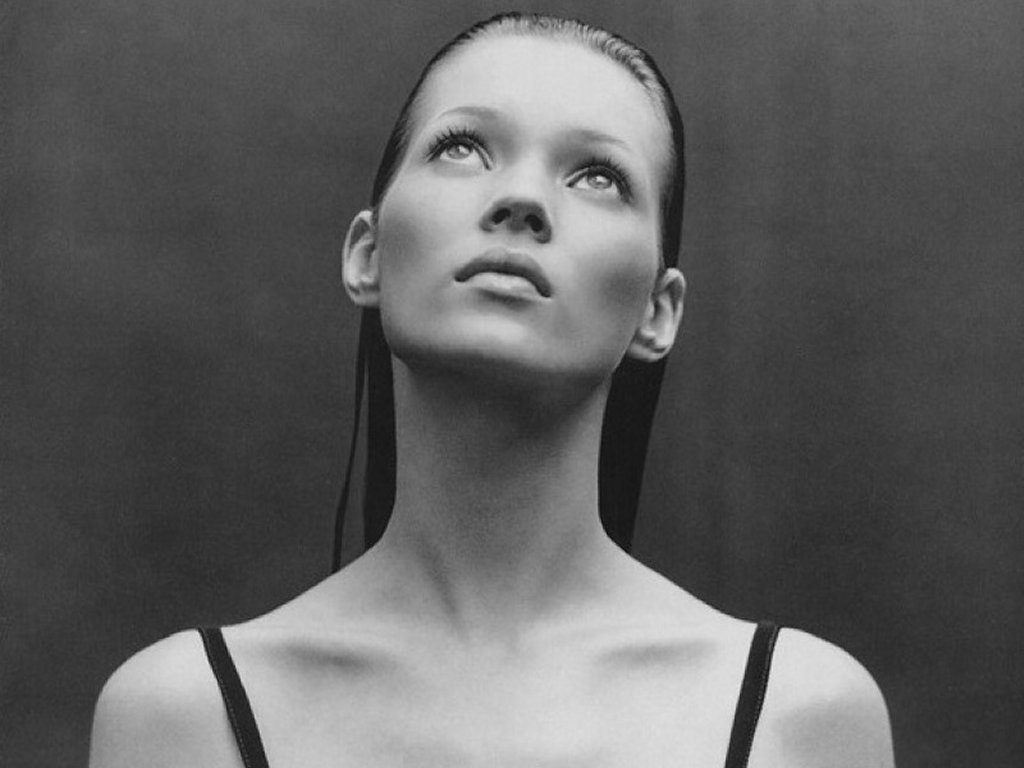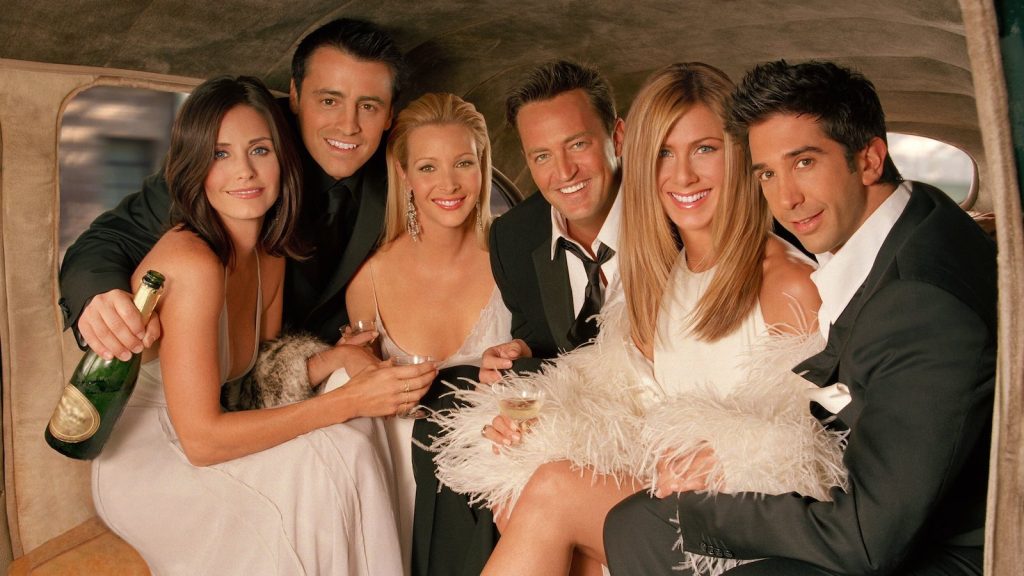The 90s slip dress, championed by supermodel Kate Moss and Gwyneth Paltrow, became a symbol of effortless elegance, while the grunge aesthetic, defined by ripped jeans, and combat boots, was worn by Courtney Love and Winona Ryder. Here are the best 90s outfits women fashion ideas highlighting timeless elegance and grace.

A still from ‘Friends.’
The rise of hip-hop fashion, with baggy jeans, crop tops and logomania, was made famous by Aaliyah, TLC, and Missy Elliott, influencing brands like Tommy Hilfiger and FUBU. Meanwhile, the preppy and sporty look, inspired by Princess Diana and the film Clueless, brought plaid skirts, knee-high socks, and varsity jackets into the mainstream. Even futuristic Y2K styles, like metallic fabrics and low-rise jeans worn by Britney Spears and Christina Aguilera, gained legendary status.
These trends were not just fashion statements but cultural movements that shaped the era and continue to inspire designers and celebrities today. Its resurgence is undeniable, with fashion designers and brands reinterpreting iconic trends through a modern design prism. The minimalist aesthetic championed by Calvin Klein in the 90s has been revived by The Row and Jil Sander, embracing sleek slip dresses, neutral tones, and structured tailoring. Meanwhile, the grunge movement popularised by Marc Jacobs’ 1993 Perry Ellis collection, has made a comeback in brands like Saint Laurent, which incorporates plaid prints and distressed denim into its designs.
Tommy Hilfiger, a staple of 90s streetwear, has embraced nostalgia by re-releasing classic pieces in collaboration with celebrities like Zendaya and Gigi Hadid. 90s outfits for women are experiencing a resurgence. Similarly, the logomania trend, once dominated by Versace and Jean Paul Gaultier, has been revived by Fendi, Gucci, and Balenciaga. This revival is driven by both nostalgia and the cyclical nature of fashion.
LIST OF CONTENTS
- Iconic 90s Outfit Trends for Women
- Fashion Designers and Brands That Shaped the 90s
- FAQS How to style 90s outfits for women
- Conclusion: Key takeaways
Iconic 90s Outfit Trends for Women
3.1. The Minimalist Chic Look
Minimalism emerged in the nineties as a stark contrast to the bold, expressive styles of the previous decade. Influenced by fashion designers Calvin Klein and Jil Sander, minimalism prioritised simplicity, clean lines, and understated elegance. This aesthetic embraced neutral colour palettes—think whites, blacks, greys, and earthy tones—and focused on high-quality fabrics and tailored silhouettes. The trend emphasised a “less is more” philosophy, leading to a wardrobe that featured essential pieces such as tailored blazers, slip dresses, and turtlenecks.

90’s minimalism emerged as a stark contrast to the bold styles of the previous decade. Image: Calvin Klein
It was also a reflection of a cultural shift towards practicality and functionality, appealing to those who favoured a polished, relaxed look. Icons like supermodel Kate Moss and the cast of TV sitcom Friends embodied this style, showcasing how minimalist fashion could be simple and chic. This 90s fashion trend steered the industry towards an appreciation for timeless pieces that emphasised quality over quantity, and continues to inspire fashion.
- Key elements: Slip dresses, monochrome outfits, turtlenecks, structured blazers.
- Inspired by: Kate Moss, Carolyn Bessette-Kennedy, Calvin Klein’s 90s campaigns.
- Modern revival: The Row, Jil Sander, Helmut Lang’s archival designs.
3.2. The Grunge Aesthetic
The 90s grunge fashion emerged as a rebellious response to mainstream culture of the time, largely fueled by the rise of the Seattle music scene and bands like Nirvana and Pearl Jam. Characterised by a dishevelled, aesthetic, grunge fashion was all about embracing an anti-establishment ethos. Key pieces included flannel shirts, ripped jeans, and combat boots, often layered for a deliberately unkempt look. This style rejected traditional notions of beauty and fashion and also reflected a broader sense of disillusionment among youth.
Grunge fashion incorporated elements from different subcultures, including punk and skate, creating a unique look that appealed to a generation seeking authenticity. Fashion accessories like beanies, chokers, and Doc Martens became staples, while thrift store finds emphasised a DIY attitude. As grunge filtered into mainstream fashion, it sparked a cultural phenomenon, influencing not just apparel and accessories but also hair and makeup, with many opting for messy hair and a natural, understated aesthetic.
Per Vogue — Famously, Marc Jacobs for Perry Ellis’ spring summer 1993 collection was inspired by the laid-back look. The collection which went down in fashion history but unfortunately gave Jacobs the boot at Perry Ellis (he was ahead of his time!) was shown in September of 1992. That December, Steven Meisel photographed Naomi Campbell and Kristen McMenamy in a memorable spread “Grunge And Glory.”
- Key elements: Flannel shirts, ripped jeans, combat boots, oversized sweaters.
- Inspired by: Nirvana, Courtney Love, Drew Barrymore.
- Modern-day revival: Marc Jacobs’ grunge collection, Saint Laurent’s plaid pieces.
3.3. Tie Dye
90s tie-dye fashion experienced a resurgence, drawing inspiration from the counterculture movements of the 1960s and 1970s. This playful, colourful style became a symbol of individuality and self-expression. Tie-dye, characterised by swirling, psychedelic patterns created through dyeing techniques, often resulted in unique pieces. T-shirts, dresses, and fashion accessories with tie-dye designs embodied a bohemian spirit.
This trend was amplified by the rise of music festivals and the growing popularity of the rave, where tie-dye became synonymous with a laid-back, party look. Celebrities and musicians helped cement tie-dye’s place in 90s fashion. The revival of tie-dye in the 90s not only showcased a love for bold colours and patterns but also highlighted a cultural desire for freedom and creativity, allowing wearers to embrace their individuality.

Tie-dye, characterised by swirling, psychedelic patterns created through dyeing techniques, often resulted in unique pieces. Image: Mango
- Key elements: swirling, psychedelic patterns created through dyeing techniques
- Inspired by: music festivals and the rave
- Modern revival:
3.4. Hip-Hop and Streetwear Influence
Hip-hop and streetwear played a pivotal role in shaping 90s fashion, transforming casual wear into a bold cultural statement. As hip-hop music gained mainstream popularity, artists like Tupac Shakur, The Notorious B.I.G., Aaliyah, and Missy Elliott became style icons, influencing global trends.
Baggy jeans, graphic tees, tracksuits, and puffer jackets became staples, reflecting the laid-back rebellious attitude of the era. Brands like Tommy Hilfiger, FUBU, Karl Kani, and Cross Colours embraced the hip-hop aesthetic, collaborating with rappers and musicians. Logo-heavy designs, from Nike and Adidas tracksuits to the iconic Coogi sweaters worn by Biggie Smalls, became status symbols, representing success and self-expression within the hip-hop community.
The influence of 90s hip-hop is evident today, as luxury brands have embraced streetwear like never before. What was once considered underground style is now a dominant force in high fashion, with labels like Louis Vuitton, Balenciaga and Off-White incorporating oversized fits, bold logos, and sneaker culture into their collections. The resurgence of bucket hats, baggy denim and chunky sneakers reflects the impact of 90s hip-hop aesthetic.

Hip-hop and streetwear played a pivotal role in shaping 90s fashion
- Key elements: Baggy jeans, crop tops, bucket hats, logo-heavy pieces.
- Inspired by: Rihanna, Travis Scott, and ASAP Rocky.
- Modern revival: Tommy Hilfiger x Aaliyah tribute collection, Adidas x Ivy Park, Supreme.
3.5. Preppy and Sporty Chic
The preppy and sporty chic aesthetic combined classic, polished elements with athletic wear. Inspired by pop culture, films like Clueless made plaid skirts, knee-high socks, and cardigan sets must-have pieces, while celebrities like Princess Diana elevated sportswear by effortlessly pairing bike shorts with sweatshirts and sneakers. Brands like Ralph Lauren, Lacoste, and Tommy Hilfiger embraced the preppy aesthetic with polo shirts, tailored blazers, and collegiate-inspired ensembles. Meanwhile, tennis skirts, varsity jackets, and co-ord sets became symbols of effortless sophistication.
The sporty chic trend also thrived through the rise of athleisure, with Nike, Adidas, and Reebok influencing street style. Tracksuits, windbreakers, and high-top sneakers became wardrobe essentials, often styled with crop tops or oversized outerwear. This era saw the dominance of logo-heavy branding, as seen in Tommy Hilfiger’s collaborations with Aaliyah and Snoop Dogg. Today, the revival of tennis skirts, varsity jackets, and retro sportswear in brands like Gucci and Adidas Originals highlights the lasting impact of 90s sporty chic.

A still from ‘Clueless.’
- Key elements: Polo shirts, tennis skirts, varsity jackets, platform sneakers.
- Inspired by: “Clueless” (Cher Horowitz), Princess Diana’s casual sportswear.
- Modern revival: Ralph Lauren Polo, Gucci’s retro sportswear, Adidas Originals.
Fashion Designers and Brands That Shaped the 90s
Calvin Klein defined 90s minimalism with sleek silhouettes and neutral tones that became synonymous with understated luxury. The brand’s iconic slip dresses, tailored suits and figure-hugging denim embodied a less-is-more philosophy. Calvin Klein’s provocative advertising campaigns, featuring Kate Moss and Mark Wahlberg in stripped-down aesthetics made clean-cut, effortless style the pinnacle of cool. The iconic Calvin Klein underwear sets, popularised by supermodels and celebrities, became a cultural phenomenon, proving that simplicity could be just as powerful as extravagance.

Calvin Klein’s provocative advertising campaigns
Gianni Versace embraced vibrant prints, opulent fabrics and daring cuts, making the brand a symbol of excess. Versace’s baroque prints, gold embellishments and Medusa logos became status symbols, worn by Madonna and Princess Diana. The legendary “That Dress”worn by Elizabeth Hurley in 1994—held together by oversized safety pins—became one of the most iconic fashion moments of the decade, encapsulating Versace’s fearless, glamorous aesthetic.
Tommy Hilfiger revolutionised street style by combining preppy American fashion with urban influences, making bold, logo-heavy casual wear a defining trend. The brand became a favorite among hip-hop artists, thanks to collaborations and endorsements from stars like Aaliyah, Snoop Dogg, and Destiny’s Child, who wore oversized Tommy Hilfiger denim, tracksuits, and varsity jackets. Hilfiger’s influence extended beyond clothing—it was a movement that championed youth culture, diversity, and the fusion of sportswear with everyday fashion, shaping the way casual-wear was perceived for decades.
Jean Paul Gaultier brought an avant-garde edge to 90s fashion with his mesh tops, tattoo-print bodysuits, and futuristic silhouettes, showing us how fashion could be artistic and rebellious. His designs blurred gender norms, with androgynous styling and unconventional fabrics, pushing the boundaries of mainstream fashion. Gaultier’s work with Madonna, including the iconic cone bra corset for her 1990 Blond Ambition Tour, cemented his reputation as a visionary. His sheer tops, cyber-inspired prints, and corsetry became defining elements of the decade, embraced by club culture, pop stars, and high-fashion enthusiasts.
FAQS How to Style 90s Outfits Today
How can I mix vintage 90s pieces with modern fashion?
Pair a slip dress with an oversized blazer, wear jeans with a crop top, or style a vintage graphic tee with leather pants. Brands like The Row and Reformation often create pieces inspired by the 90s.
What are some layering techniques for a perfect 90s-inspired outfit?
Try wearing a turtleneck under a slip dress, an oversized blazer over a crop top, or a denim jacket over a hoodie for a streetwear vibe. Baggy pants paired with fitted tops also create a 90s silhouette.
What accessories should I wear for an authentic 90s look?
Opt for chunky sneakers like Fila Disruptors or Adidas Superstars, tiny sunglasses, mini shoulder bags like Prada Re-Edition 2000, chokers, and butterfly clips for a nostalgic touch.
Where can I find authentic 90s fashion pieces?
For true vintage finds, check thrift stores, flea markets, and resale platforms like Depop, The RealReal, and Vestiaire Collective. Brands like Levi’s, Tommy Hilfiger and Calvin Klein often have reissued collections.
How do I style 90s streetwear without looking outdated?
Pair baggy jeans with a fitted crop top, or an oversized hoodie with biker shorts. Stick to streetwear brands like Supreme, Adidas Originals and Champion, and incorporate statement sneakers for a fresh, retro look.
Celebrities who influenced 90s outfits for women
One of the most iconic figures of the decade was supermodel Kate Moss, whose presence in the fashion industry marked a shift towards a laid back aesthetic, often referred to as “heroin chic.” With her fondness for slip dresses, vintage denim, and oversized blazers, Moss embodied the cool, laid-back vibe of the era. Her ability to fuse couture with street style made her an influential muse for fashion designers.

One of the most iconic figures of the decade was supermodel Kate Moss
Jennifer Aniston, through her role as Rachel Green on Friends, was a fashion icon. The character’s wardrobe showcased a perfect combination of casual and polished pieces, introducing high-waist jeans, crop tops, and blazers. Aniston’s “Rachel” haircut sparked a wave of interest, with fans rushing to salons to replicate the look. Her relatable chic style appealed to many women, making her a key figure in popularising 90s fashion staples that emphasised both comfort and sophistication.
Another significant influencer was Gwen Stefani, whose bold choices—crop tops, plaid skirts, and vibrant hair colours—encouraged fans to embrace their individuality and experiment with their style. Her signature red lipstick and eclectic fashion accessories cemented her status as a style icon, inspiring a generation to mix and match elements of diverse fashion trends.
Conclusion: Key takeaways
90s outfits for women are experiencing a resurgence. Social media platforms like Instagram have played a crucial role in this revival, with influencers and fashion enthusiasts showcasing vintage looks. From grunge-inspired oversized flannel shirts and ripped jeans to slip dresses, these trends are being reimagined and incorporated into contemporary wardrobes. Brands are tapping into this nostalgia, launching collections that pay homage to the past while adding fresh twists, such as modern silhouettes that make these styles more accessible for today’s fashion-forward individuals.
Moreover, the resurgence of 90s fashion trends is also a reflection of shifting cultural values, where comfort and individuality are prioritised. The era’s eclectic styles—from streetwear to bohemian looks—encourages personal expression, allowing wearers to curate outfits that feel authentic. The popularity of thrift shopping and sustainable fashion further fuels this trend, as people seek out unique, vintage pieces that tell a story. As a result, 90s fashion is not just a fleeting trend but a movement that champions creativity and sustainability, reminding us that iconic styles transcend time while adapting to the evolving landscape of fashion.
Jasmeen Dugal is Associate Editor at FashionABC, contributing her insights on fashion, technology, and sustainability. She brings with herself more than two decades of editorial experience, working for national newspapers and luxury magazines in India.
Jasmeen Dugal has worked with exchange4media as a senior writer contributing articles on the country’s advertising and marketing movements, and then with Condenast India as Net Editor where she helmed Vogue India’s official website in terms of design, layout and daily content. Besides this, she is also an entrepreneur running her own luxury portal, Explosivefashion, which highlights the latest in luxury fashion and hospitality.











